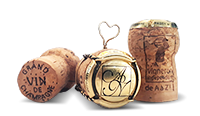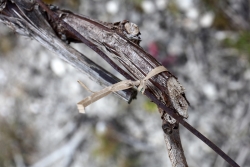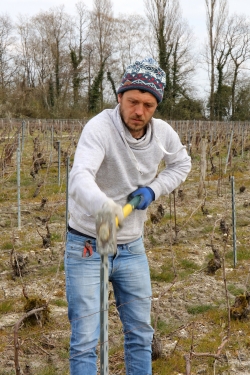Vineyard task
Throughout the year, the vine requires constant attention. Pruning, tying, bud removal, harvesting… Every step is essential to ensure grape quality and express the full potential of the Champagne terroir. This precise know-how is handed down from generation to generation.
In Champagne, tending the vineyard is an art that unfolds across the seasons, guided by a time-honored expertise. Every task is aimed at supporting the vine, preserving its natural balance, and ensuring the quality of the harvest. Here are the main stages of this meticulous cycle:
Winter Pruning
Carried out between November and March, pruning is one of the most technical and strategic tasks of the year. It helps control the vigor of the vine, regulate yields, and shape the vegetative structure for the coming season. In Champagne, pruning is strictly regulated, with methods such as Chablis, Cordon de Royat, and Guyot—each adapted to the grape variety and terroir.
Tying (Liage)
Once pruning is complete, the selected canes are bent and tied by hand to the trellising wires using biodegradable ties. This springtime task ensures proper orientation of the shoots and harmonious distribution of future vegetation. It requires precision and dexterity.
Repairs and Maintenance
Before the vine awakens, March is the ideal time to inspect and repair wires and stakes, ensuring a strong framework to support the growing vine throughout the season.
Disbudding (Ébourgeonnage)
When the first buds appear, those that are poorly positioned or non-fruit-bearing are removed. This focuses the vine's energy on the most promising shoots, improving grape aeration and promoting even ripening. It also helps reduce the risk of fungal diseases.
Lifting (Relevage)
As the vine grows, the shoots lengthen and must be held between the trellis wires. Lifting is performed in several passes, raising and securing the shoots to protect them from the wind, prevent tangling, and structure the canopy efficiently.
Trellising (Palissage)
Trellising complements lifting by spacing the shoots vertically. This ensures optimal sunlight exposure and better air circulation among the grape clusters—both vital for photosynthesis and disease prevention. It also facilitates treatments and vineyard access.
Trimming (Rognage)
In summer, when the foliage becomes dense, trimming controls the height and width of the vine by cutting back shoot tips. This limits shading, improves sugar concentration in the berries, and maintains balance between leaf growth and grape ripening.
Spaying (Traitement)
Throughout the growing cycle, the vine is vulnerable to diseases such as downy and powdery mildew. Preventive treatments are therefore applied, with increasing focus on reducing chemical inputs. Many estates now adopt sustainable, integrated, organic, or even biodynamic practices to preserve soil health, biodiversity, and overall vineyard resilience.






